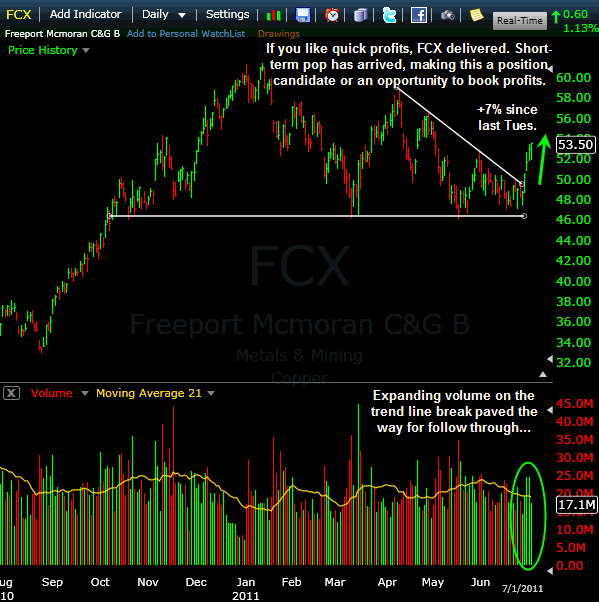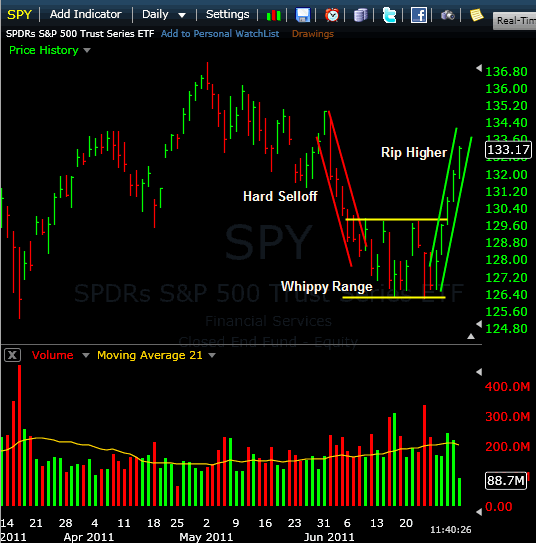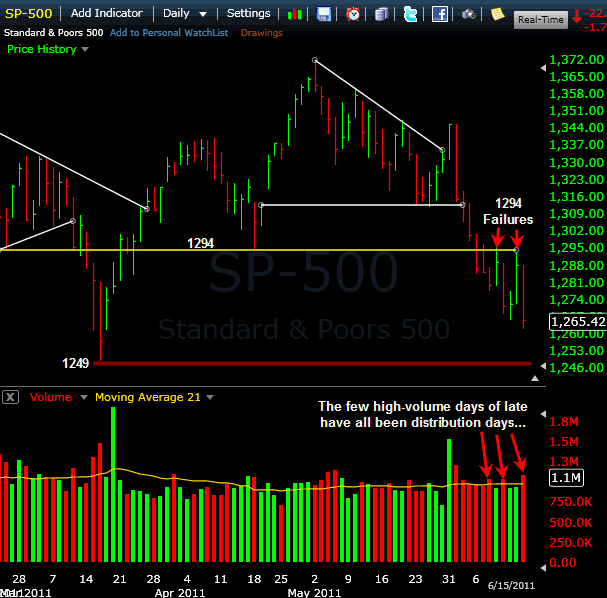Search Results for 'traders'
FCX 7% in 3.5 Days, Time to Lighten Up
Last Tuesday I pointed out FCX as not only a potential market tell (since copper has proven to be a leading indicator many times), but also as a breakout play through a trend line after holding key support. That post was published as the stock threatened to break $50.
Fast-forward 3 1/2 trading sessions, and FCX now sits at $53.50, or 7% higher. That’s a quick pop (which I hope you caught a piece of at the very least), so the fast money has been made. While the stock looks great for an intermediate-term position play, for short-term traders it’s time to lighten up.
A pullback is going to come, so for those only interested in grabbing the initial move, this is it. Ring the register and move on to the next play.
Here’s a look at FCX, showing the push through the descending trend line and a rally past the previous high from May 31. Not bad for a freebie:
Trade Like a Bandit!
Jeff White
Producer of The Bandit Broadcast
Tricky Times
I’ll begin this post with a plain and simple statement that is always true, including now: the market is tricky. It is never easy, and anyone who tells you it is easy is either lying or an ignoramus.
With that said, if you’ve struggled of late, you have company. Traders of many timeframes have found these past several weeks to be quite challenging. During the past 6 weeks, here are a few phases we’ve witnessed:
Swift move lower. June kicked off with total abandonment of stocks as the indexes shed several percentage points in the opening days of the month. It was flat-out hard to get on board if you missed the initial turn. It rewarded chasing.
Whippy trading range. Following the initial slide, the market settled into a trading range marked by volatile shifts of direction and frequent reversals. It offered zero follow through. Chasing rallies or selloffs resulted in immediate pain as prices turned on a dime to revert back to the other end of the range. It rewarded fade trades.
Aggressive ascent. After a selloff and indecision, in recent days we’ve seen the market ramp relentlessly higher with upside gaps and rips inviting bulls off the sidelines while forcing bears to cover their shorts. Again, chasing has been rewarded.
Chasing strength or weakness isn’t inherently wrong, and you can make fast money if you’re good at it. Likewise, fade trading within ranges isn’t wrong either, so long as you know what you’re doing and you stick with your discipline. But for the trend-following trader who prefers to see stocks run, base, then run again, this market has offered little for you. It has been tougher sledding of late, regardless of whether you’re a bull or a bear, a momentum trader or a continuation player, a day trader or a swing trader. It has been a mess, so if you’ve struggled, that’s part of the reason.
Here’s a look at SPY showing the three phases of the past 6 weeks:
Good News
There is good news.
First, from a technical standpoint we know that the further this rally carries, the more likely the March & June lows are to hold. It just gives the market more breathing room for the next pullback (and we will see one).
Second, conditions are always changing. Just as in recent weeks we’ve seen nonstop selling, complete indecision, and then aggressive buying, going forward we’ll see a variety of conditions as well. That’s good, because it means at some point your ideal trading environment is going to arrive again. But you’ve gotta be ready for it. You can’t have your head down and be busy bemoaning the fact that you’ve missed a couple of moves.
Finally, this is a reminder to step up your game. It’s an opportunity for growth – a wake-up call. Missing out is only partly the market’s fault – the rest is in your hands. Learn some new methods, learn to assess conditions better, and understand which strategies are best suited for the environment you’re facing. Don’t be stagnant, or else you’re going to continue to find frustration anytime the market doesn’t cater to your current skills. Build your skills and become a more complete trader.
Attitude Matters
At all times you can complain and look back and wish you had seen a move coming or had the courage to join the momentum crowd. That’s always something you can choose to do, but honestly, it’s not going to help you. That’s not a winning attitude.
But take heart if you’ve struggled lately. Things will smooth out and when they do, you’ll have experienced a few more market moves to file away in the mental vault – ideally to serve you again later – and that means you’ll more readily identify opportunities you used to miss out on.
Stay on your toes, the market gives nothing away.
Trade Like a Bandit!
Jeff White
Producer of The Bandit Broadcast
Obscurity and Opportunity
Prolonged market rallies have a way of pulling obscure stocks off the sidelines and getting them involved in the action. It’s the effect of “a rising tide lifts all boats.”
And that’s entirely fine. It’s nice when new names are added to the mix of active stocks.
The market turned higher in March 2009, and since then we’ve seen considerable progress. Tons of little names have entered the fray, paying astute traders along the way (unintentional rhyme).
While I do have some restrictions on what I will and will not trade, I don’t mind trading some of the more obscure names when they’re set up for moves – so long as they exhibit the proper traits:
Size Matters
 Dirt-cheap, thin stocks are not worth trading. They carry much greater potential for pain than profit, despite their inexpensive price tags. But growing stocks (price & volume growth, not necessarily earnings growth) are another story. Every big run starts somewhere, right?
Dirt-cheap, thin stocks are not worth trading. They carry much greater potential for pain than profit, despite their inexpensive price tags. But growing stocks (price & volume growth, not necessarily earnings growth) are another story. Every big run starts somewhere, right?
There’s often a relationship between ‘unknown’ and ‘underowned’ and that can spell exceptional opportunity. Under-the-radar stocks often times begin to exhibit technical characteristics worth noting, raising interest in them in such a way that they’re the up-and-coming stocks. Naturally, they’re little-known, and that means they’re underowned by institutions (the ones who really move stocks). As they exhibit some staying power, interest in them grows. That brings both price and volume up to tradeable levels, placing them squarely on the watch lists of traders like you and me.
(I’m talking to mostly guys here, so ladies please bear with me on this next analogy. I want these guys to “get it” so they know what I’m talking about.)
Think of that co-ed in college who returned from summer looking far better than the previous semester. What happened? Suddenly she has the attention of many more guys, has more dates, and as competition for her time expands, so does her confidence. Now that she’s being noticed, she’s unlikely to regain the 15 she lost and return to the sweats-with-no-makeup look again. (Nothing against the natural, casual look… just stating that a change is likely to last in this case). She’ll quite likely take care of herself better, and interest in her will be maintained as a result.
Stocks sometimes follow a similar path.
Beware the Flash in the Pan
As the phrase states, “one day does not a trend make.” Therefore, it makes sense to make a stock prove itself – at least for a little while – before taking a position.
The single-day spurt higher on news will bring no-name stocks into view on a regular basis, but most of those are just having their 15 minutes of fame. If what you’re seeing is just a knee-jerk response to a headline, there’s limited opportunity and that stock is likely to drift right back into obscurity. Avoid those.
Instead, as a stock begins to earn respect (and attention), watch for the key characteristics that it’s starting to trend: expanding volume, higher highs and higher lows, and a good price/volume relationship. These stocks are much more likely to stick around and offer you multiple opportunities to participate and profit.
Trade Like a Bandit!
Jeff White
Producer of The Bandit Broadcast
Be Imperfect!
 Society trains us to want to be perfect. And in many endeavors, that’s something worth striving for. Surgeons, for example, can put you at ease when they tell you they’ve performed this operation hundreds of times without any problems. Students with perfect grades get academic scholarships, saving boatloads of tuition money. And the list of examples of the benefits of perfection goes on and on.
Society trains us to want to be perfect. And in many endeavors, that’s something worth striving for. Surgeons, for example, can put you at ease when they tell you they’ve performed this operation hundreds of times without any problems. Students with perfect grades get academic scholarships, saving boatloads of tuition money. And the list of examples of the benefits of perfection goes on and on.
From our appearance to our performance, someone else will always be a little better, and it causes us to try to perfect whatever it is we’re doing for the sake of improvement (or keeping up). Unfortunately, it carries over into our trading – much to our detriment.
You see, when it comes to trading, there’s no room on the perfection list. And that’s a good thing, because perfection isn’t required for success.
The very worst traders try to be perfect. They either stay sidelined in search of a perfect strategy (backtesting galore), or they practice trade until they make $1M in hopes of duplicating it live, or they simply refuse to lose.
Perfection in trading is paralyzing, both to you and your account. Growth is prevented, confidence suffers, and you feed the very traits you should strive to shun.
I’ve said before that in trading, you succeed by not failing. But that doesn’t mean you can’t have failed trades – quite the contrary. Expect losses! As negative as that might sound, it will mentally prepare you to accept them gracefully and move on to the next trade which might be a far bigger winner).
The best traders are imperfect – by choice. They grow from mistakes, not successes. Lose small and face the music when your current approach isn’t working. That shows true confidence. By definition, imperfection brings opportunities for growth – both in your account (lose small and win bigger) and in your abilities as a trader (learn new methods). But you’ll miss out if you’re not willing to bend.
Trade Like a Bandit!
Jeff White
Producer of The Bandit Broadcast
Caught In A Trap
Anytime the market tanks like it has lately, astute traders realize that shorting after a decline of this magnitude and momentum is a real potential bear trap. A sharp rebound could come at any time, leaving late shorts in a world of hurt.
I can’t and won’t argue with that – in the short term.
But the further this market declines in the intermediate term, the growing group of trapped traders are the bulls. Keep in mind that the past few weeks have been a big shift of character for this market, with the prevailing mantra moving from buy-all-dips to sell-all-rallies. Technically, that’s very important to recognize.
And while a sizeable bounce will eventually arrive, the important issue for most bulls is “from what level?”
Head Games
That brings into play the psychological aspect of this change of character, whereby not only do bulls become fearful, but the bears gain confidence. Bulls who bought virtually anytime over the past few months are now underwater, and the deeper this correction goes, the more that late-to-the-rally-party group wants out.
That could quite easily play out with bulls selling on the way back up – just the opposite of a few weeks ago when trapped bears covered on every little dip. By the same token, just as a few weeks ago we were still seeing underinvested or aggressive bulls put more cash to work on even minor pullbacks, the deeper this correction goes, the more the bears will be using bounces to remount short positions. That means what used to be buying by both camps is quickly morphing into selling by both camps.
A spring back up will at some point arrive, so fear not – this market is still a 2-way street. But for now, respect for the tape should remain very high, because anything is still possible. Whenever the inevitable recoil of this selloff kicks in, keep in mind that it too could get faded, and therefore will have to earn your trust.
Here’s a look at the S&P right now with the March lows coming quickly into view at 1249 (which may need to get broken before a real bounce happens):
Trade Like a Bandit!
Jeff White
Producer of The Bandit Broadcast
YOUR Trading Plan, Part 2
 In Part 1, I put forth some questions that need to be answered by you in order to move forward with any lasting effect. Those help you identify what it is you’re after, what styles you should pursue, and which approaches you should completely avoid. Let’s proceed.
In Part 1, I put forth some questions that need to be answered by you in order to move forward with any lasting effect. Those help you identify what it is you’re after, what styles you should pursue, and which approaches you should completely avoid. Let’s proceed.
Start With the Basics
Understanding your preferences, biases, needs and availabilities will clarify your basic approach.
For example, if you were trading a retirement account (non-margin, and thus no short selling, and you prefer the long side and capturing segments of uptrends, you’ve got a starting point. You might narrow your focus to a long-only style based on patterns such as resistance breakouts, as well as bullish continuation patterns like bull flags, bull pennants, and ascending triangles. Those are easily identifiable patterns, which is nice, so you should have a steady flow of candidates to suit your needs.
See what I meant in Part 1 when I said trading allows you a custom-designed approach?
Go Big AND Go Home
Next, decide on a risk amount per trade, in terms of potential dollar loss – not in terms of cash outlay. Think in terms of “real risk” or what you’re truly risking before exiting on the downside. This is the amount you’re willing to lose if/when you are wrong.
That sounds negative, but it’s crucial. Whether it’s $200 or $500 or $5,000 doesn’t matter, so long as it’s a suitable amount of risk for your unique situation. The amount itself is of secondary importance to simply having an amount. It’s a starting point for every trade.
Too many traders fail to begin with an amount of risk they can stomach, and they trade too big and pay the price. That’s no good, so always aim to trade within your means so you can survive and make good decisions.
For example, let’s say your risk amount is $200 per trade. This is what you’re willing and able to risk (lose) if the play doesn’t work out.
So take a trade in XYZ with a pattern that suits you, like an ascending triangle pattern. A breakout might be at $18, and a failure might be at $16. So you could go long this hypothetical trade at $18 with a $16 stop. That’s a $2 per share stop, and you’ll risk $200 per trade, so you could buy 100 shares. Easy math. It doesn’t have to be complicated to be helpful to your trading.
See how knowing *the number* for you can help you understand how much to be trading? The strategy itself is based on the pattern confirmation (entry) or failure (stop loss), but your position size comes down to what you’ll risk per trade. Few traders incorporate this into their plan, but if they did, they’d be miles ahead and avoid many painful trading disasters as well.
In part 3, I’ll wrap this up with some specifics for your overall process. Until then, decide on some basics which suit you and figure out your ‘number.’
Trade Like a Bandit!
Jeff White
Producer of The Bandit Broadcast
YOUR Trading Plan, Part 1
 You are unique (and you don’t need me to tell you that). The desire to find a trading plan that’s right for YOU is of paramount importance, because we are all a little different.
You are unique (and you don’t need me to tell you that). The desire to find a trading plan that’s right for YOU is of paramount importance, because we are all a little different.
When it comes to your chosen trading methodology, you need to determine a number of things about yourself before going forward. These are things like your trading timeframe, risk tolerance, directional bias, and desired setups to pursue.
That’s the beauty of trading, you know. The market offers you the ability to custom-design an approach that works for YOU. Ask yourself questions such as…
* Will you be day trading for smaller but more frequent profits, or will you be entering positions for several days or weeks?
* Will you be comfortable keeping tight stops of just a few percent, or are you comfortable allowing more breathing room for trades in order to reach a more distant profit objective?
* Are you comfortable short selling, or do you prefer to only buy stocks?
* Are there specific patterns which you really like to trade or have found success with, such as buying dips within uptrends or perhaps buying breakouts?
These kinds of questions which can only be answered by you, but you MUST determine those answers in order to be effective. Those answers are paramount to your finding the proper strategy for YOU. I cannot emphasize that enough. Otherwise, you’ll be chasing different strategies by the day, but never knowing what’s working best and what to completely avoid. And if you’re dabbling in strategies which don’t suit you, you will not trust them or commit to them.
So when it comes to your trading plan, the more clear you can be on who you are, the more clearly you can define what it is you should be trading – and (equally important) what you should NOT be trading. That last part gets many traders in trouble, they stray into unfamiliar territory and find themselves making poor decisions which prove costly.
Since this is Part 1, there’s obviously more to come. But before the next part arrives, you have some homework to do – answer those questions above. I don’t want to know the answers to them, but you’re going to need them. Otherwise, the info to follow will carry no significance to you, rendering your time (and mine) completely wasted. Don’t be “that guy!”
I’ll see you in Part 2.
Trade Like a Bandit!
Jeff White
Producer of The Bandit Broadcast








